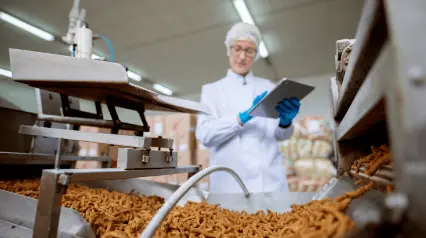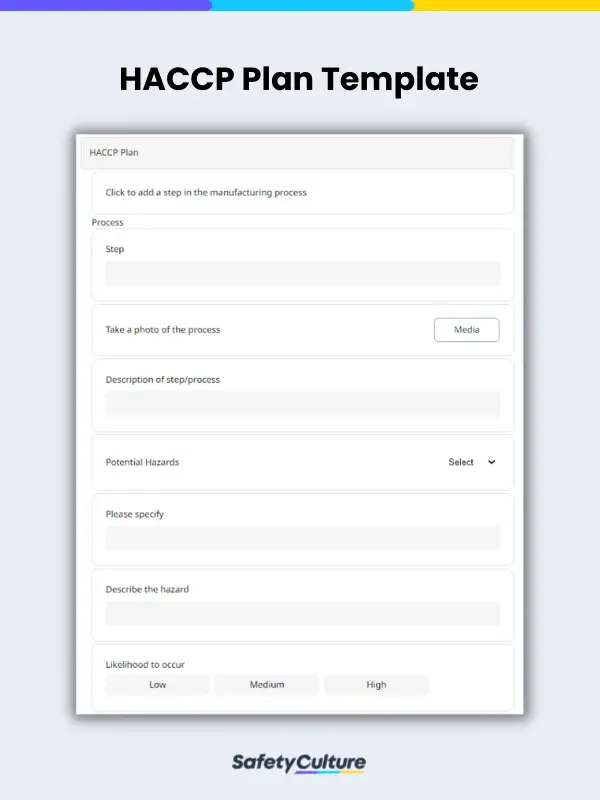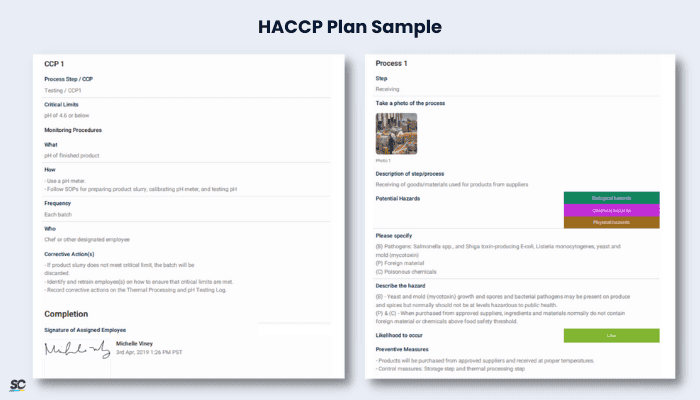What is a HACCP Plan?
A HACCP plan is a written document used by businesses as a guide in implementing the principles of HACCP. Also known as the Hazard Analysis and Critical Control Points plan, it is a food safety monitoring system that helps identify and control biological, chemical, and physical hazards within the storage, transportation, use, preparation, and sale of perishable goods. It also determines critical control points (CCP) in the process of food production. Create a HACCP plan to mitigate risks of food contamination and avoid legal issues caused by foodborne illnesses.
Why do I need it?
Having a HACCP plan is a cost-effective way to manage food safety and sanitation systems which is essential to the success of your food business. HACCP Compliance benefits your food business in many ways, some of which are:
- Avoid costly fines caused by food safety and hygiene offences
- Build a strong reputation that attracts more customers
- Improve quality and safety of food products
- Reduces downtime and boosts productivity
- Provides due diligence defense
5 Steps to Get You Started
A good HACCP plan is founded on the right team, the right vision, and the collective diligence to carry out each step to guarantee food safety. To guide you on how to write and develop your own set of HACCP plans, below are 5 steps you can follow to get started:
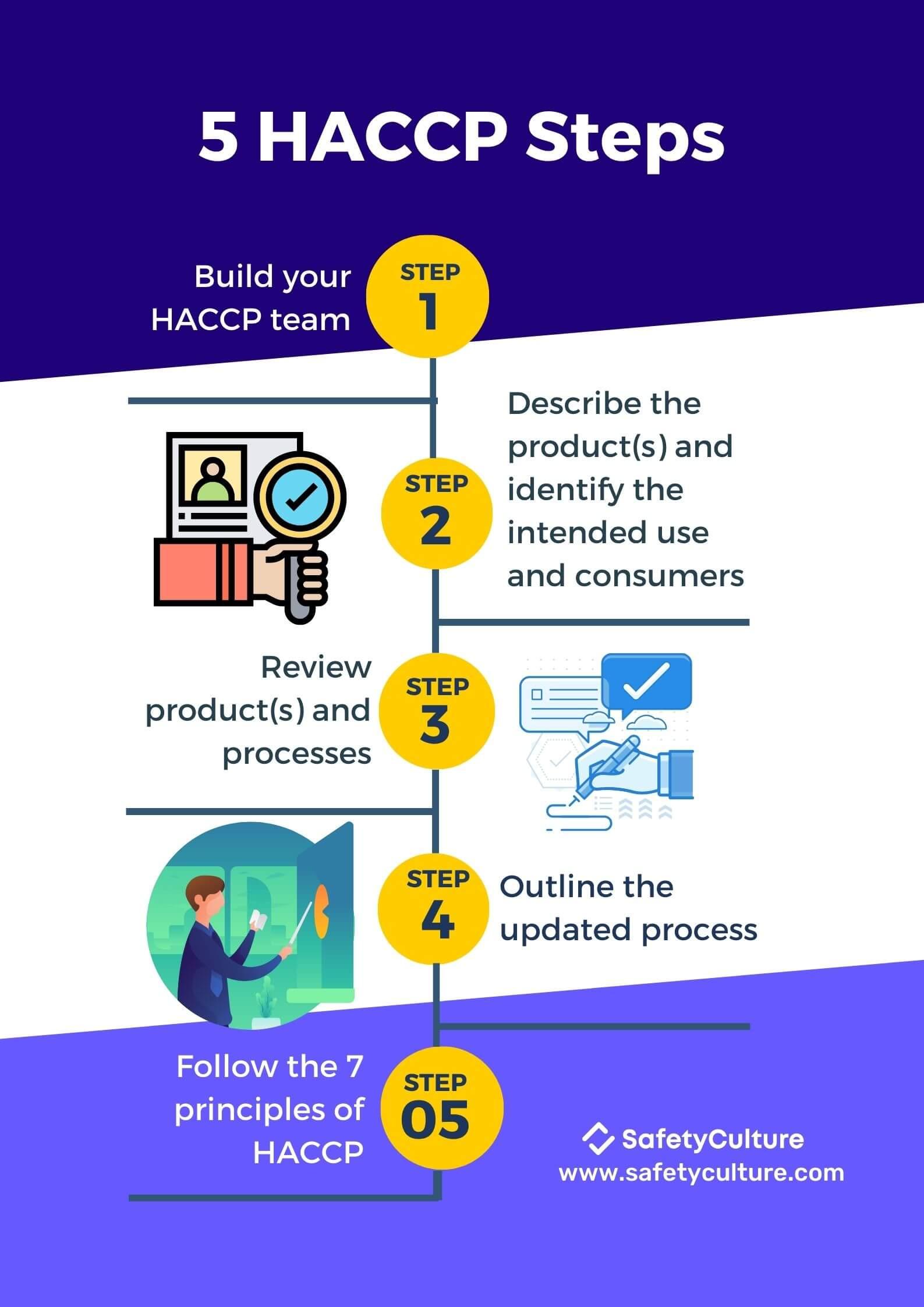
5 HACCP Steps to develop a solid HACCP plan
Step 1: Build your HACCP team
The quality of your HACCP team is the foundation of your HACCP success. When building your HACCP team, you need to include individuals that have proven their knowledge and expertise in their respective fields. Recruit at least one individual from the following disciplines:
- Food engineering
- Quality assurance
- Cleanliness and sanitation
- Machine operations General labor
Having an interdisciplinary team grants you insight into all of the important food safety aspects of your operation. Knowing what to look out for helps you prepare the right preventive measures to mitigate food safety risks.
Step 2: Describe the product(s) and identify the intended use and consumers
This step involves providing a general description of the food, stating details such as ingredients, processing methods, and method of distribution (e.g., frozen, refrigerated, or at a certain temperature.) Along with this information, also state the expected use of the food and the intended consumers (e.g., general public, infants, elderly, immunocompromised individuals, etc.)
Step 3: Review product(s) and processes
The majority of employees, in their performance of day-to-day tasks, tend to take the details of their work for granted. This happens mostly because processes turn into habits through repetition. Habits, however, may persist even if they are no longer efficient.
Reviewing food products and processes helps the HACCP team determine whether the current internal food safety processes and standards are still relevant and efficient. This way, revisions, and updates can be made to ensure the safety of food products from preparation to delivery.
Step 4: Outline the updated process
After applying the necessary adjustments to the process, the HACCP team must outline the updated process in a clear and understandable manner for employees to follow. A flow diagram can be used since its linear format can help avoid confusion regarding the order of process steps.
Step 5: Follow the 7 principles of HACCP
At this point, your HACCP team will then proceed to perform the 7 principles of HACCP, which are as follows:
- Conduct a hazard analysis
- Determine the CCPs
- Establish critical limits of CCPs
- Set Up a monitoring system
- Establish corrective actions
- Establish verification procedures
- Establish documentation
HACCP Plan Example & How to Write it in 3 Steps
Once you’ve met the prerequisites of a HACCP plan, you can begin documenting. In this guide, we’ve summed up the process into three steps based on the 7 principles of a HACCP plan.
Principle #1: Write Down Your Process
Building a HACCP Plan begins with listing down the steps in the production process. This step involves conducting the HACCP principle of conducting a hazard analysis. Therefore, you have to write down the following information:
- general description of the step or process;
- the potential hazards it’s exposed to (e.g., biological, chemical, or physical);
- it’s likelihood;
- the preventive measures; and
- photo of the process or procedure for a more comprehensive plan.
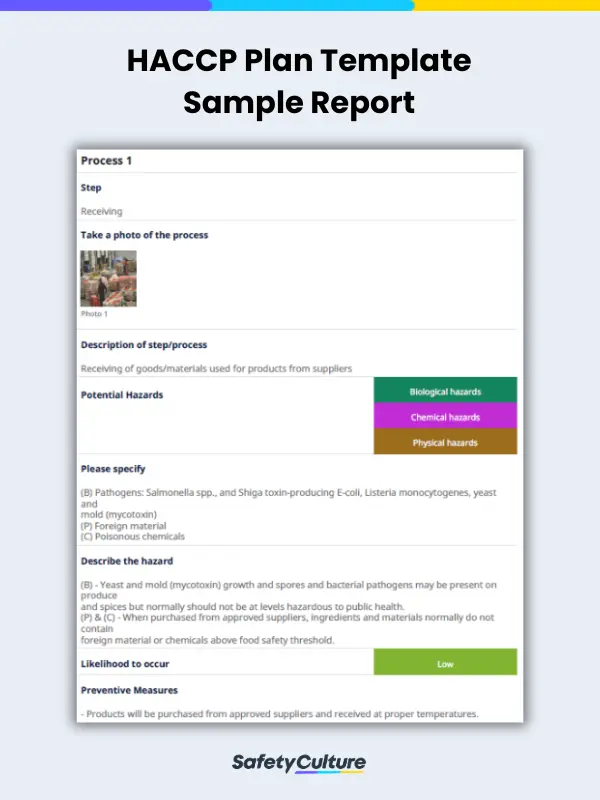
HACCP Plan Sample Report
Principle #2: Determine CCPs and Establish Critical Limits & Monitoring Procedures
In this step, you will need to identify which processes a critical control point (CCP) must be applied to eliminate food safety hazards (e.g., receiving, sorting, handling, or testing). As you write down critical control points, a critical limit should also be specified. A critical limit is the minimum or maximum value that must be met by the control measure to prevent, eliminate or reduce the hazard.
After establishing the critical limits, a monitoring procedure should then be provided to help the staff track that each limit has been met. This enables staff to maintain food safety during the food production process. Monitoring procedures can be written by defining the following:
-
- What is being monitored?
- How should it be measured?
- How frequent should it be checked?
- Who is responsible for checking?
HACCP Example:
| Critical Control Point (CCP) | Critical Limit | Monitoring Procedure |
| Testing | pH of 4.6 or below | Use a pH meter to measure the pH of the finished product. This should be done for every batch by the Chef in charge or any other designated employee. |
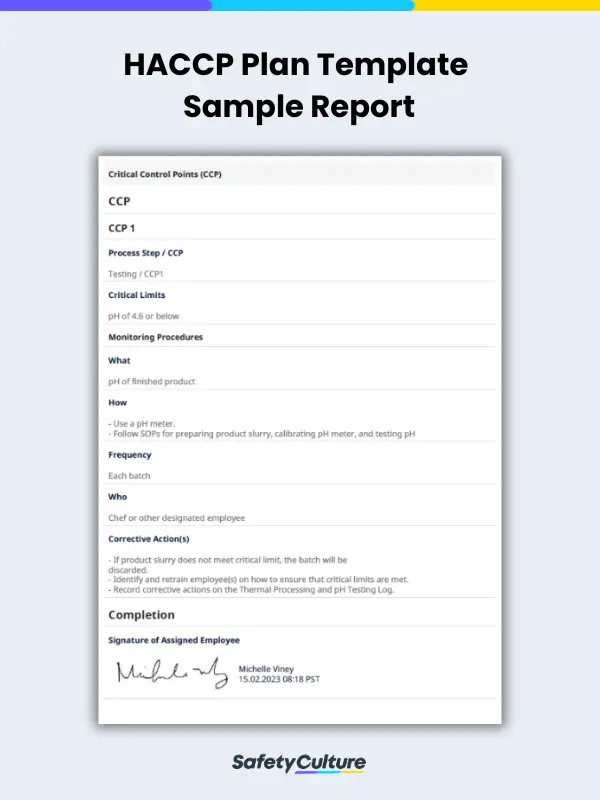
HACCP Plan Sample Report
Principle #3: Provide a Corrective Action
Corrective actions are the steps taken when deviation occurs during the food production process. This allows staff members to take the proper action needed to prevent contamination or any other foodborne illnesses. Corrective actions can vary to either, recooking or reheating or disposal. Example of a corrective action: If the finished product is slurry and did not meet the critical limit, the food product and its batch should be discarded. To give you an idea of what it looks like, we’ve provided a HACCP plan example below:
What is a HACCP Plan Template?
A HACCP plan template is a ready-to-use tool that many food establishments utilize as a guide in establishing an effective HACCP system. It contains all the necessary information to create a comprehensive HACCP plan and helps businesses ensure that no critical aspects of the plan are missed.
Digital HACCP plan templates can also help improve tedious workflows that involve paper forms, spreadsheets, scanning, faxing, and manual recordkeeping.
What to Include in a HACCP Plan Template
Since a HACCP plan requires a very specific set of items to go through, a HACCP plan template typically includes the following elements:
- Title Page – Add the key information needed for the specific use such as reference number, establishment name, intended use and consumer, and important dates to note.
- Process – Specify the manufacturing procedure to be assessed. A manufacturing process can comprise multiple steps so make sure to include all of these.
- Hazard analysis – Identify potential hazards in the food production process including biological, chemical, and physical hazards. This analysis helps determine the CCPs where control measures can be implemented.
- CCPs – Determine the critical control points in the production process where control measures can be implemented to prevent, eliminate, or reduce the identified hazards.
- Critical limits – Define the specific criteria for each CCP that must be met to prevent or eliminate the hazard, such as temperature, pH, time, and moisture.
- Monitoring procedures – Establish how the CCPs will be monitored, who will perform the monitoring, and how frequently. Monitoring ensures that the critical limits are being met and that the control measures are working effectively.
- Corrective action – Specify the actions that will be taken if the critical limits are not met, such as adjusting the process, reworking the product, or discarding it totally.
- Completion – Complete the template used by adding a digital signature of the assigned employee.
FAQs about HACCP Plan
It is not mandatory for most businesses in the food industry to have a HACCP plan or system. However, it is critical to have a food safety management system to significantly control health hazards. Such is an ultimate responsibility of food businesses in the industry.
Establishing critical limits can help in distinguishing safe and acceptable products from unsafe and unacceptable. A critical limit is a standard that must be met to prevent, eliminate, or reduce the occurrence of food safety hazards. Examples of this include measuring time, temperature, and other measures derived from regulatory standards.
Corrective actions must be identified and developed once CCPs have been determined. A corrective action details the steps to take if critical limits for a CCP are not met. In a haccp plan, corrective actions should be written specific to each hazard and CCP.
